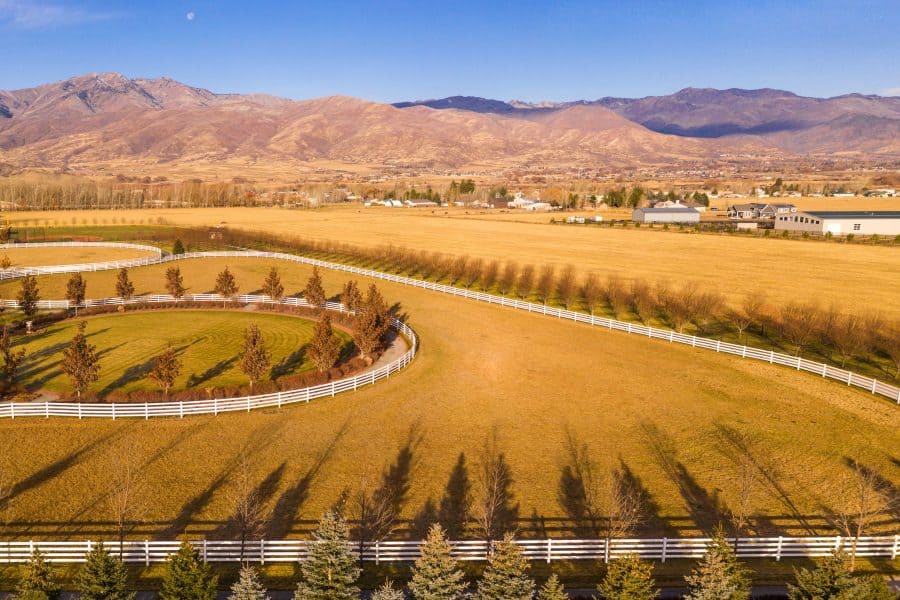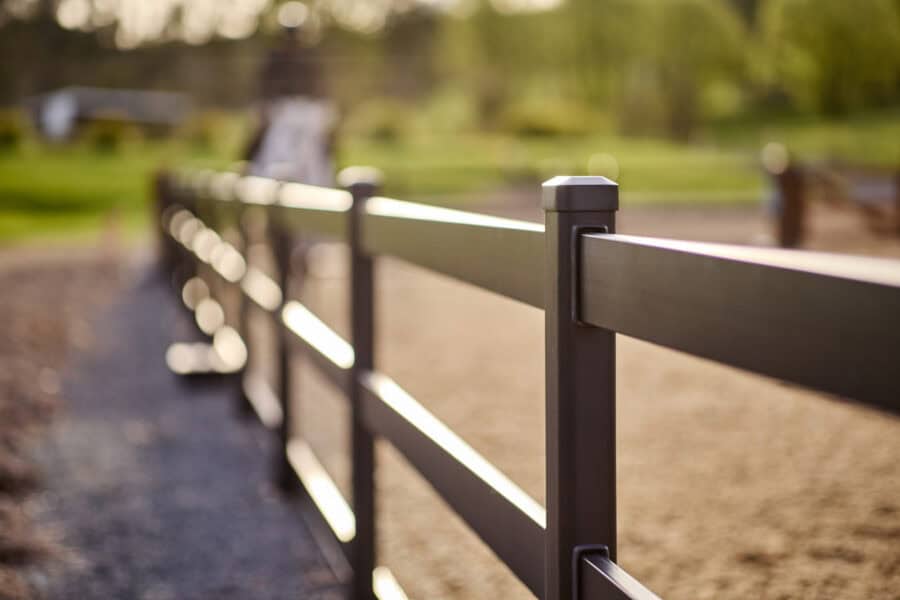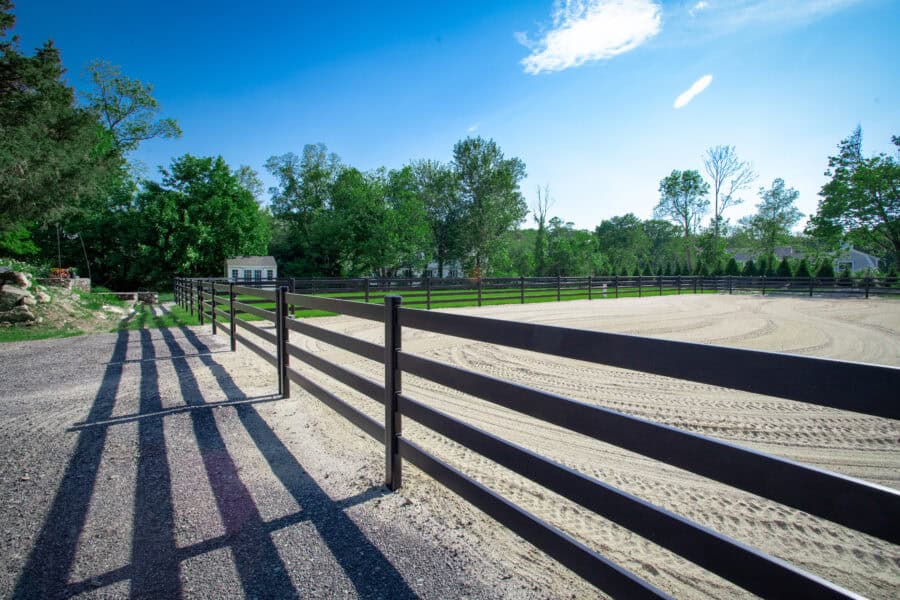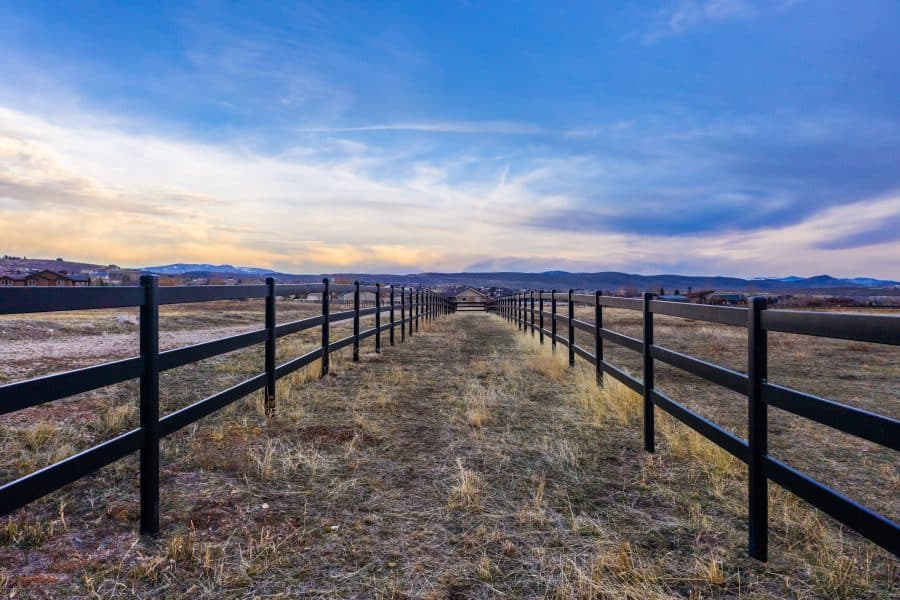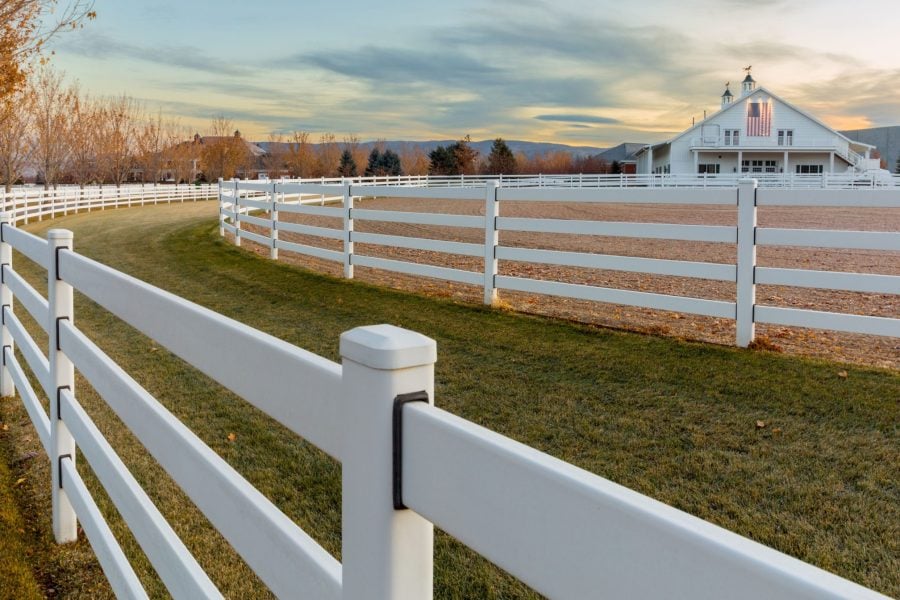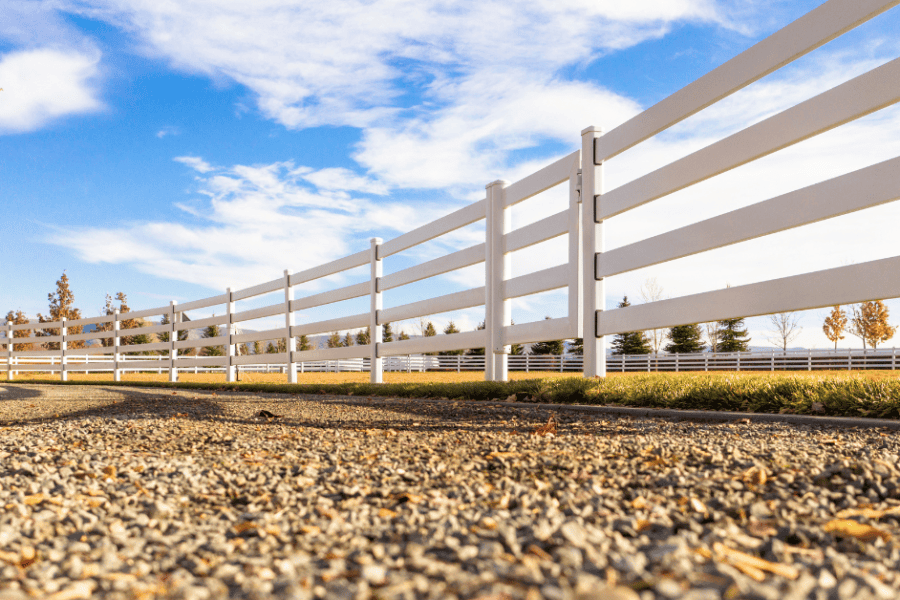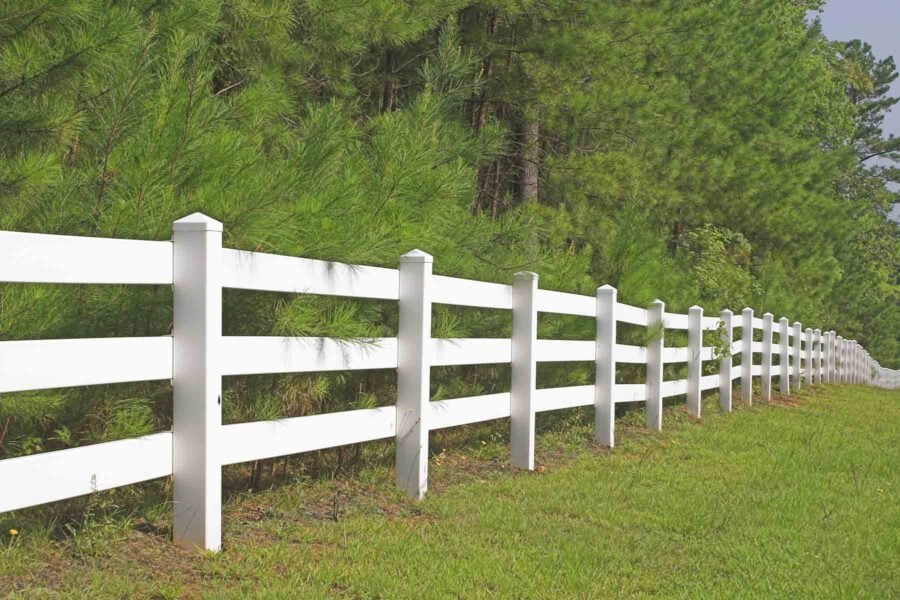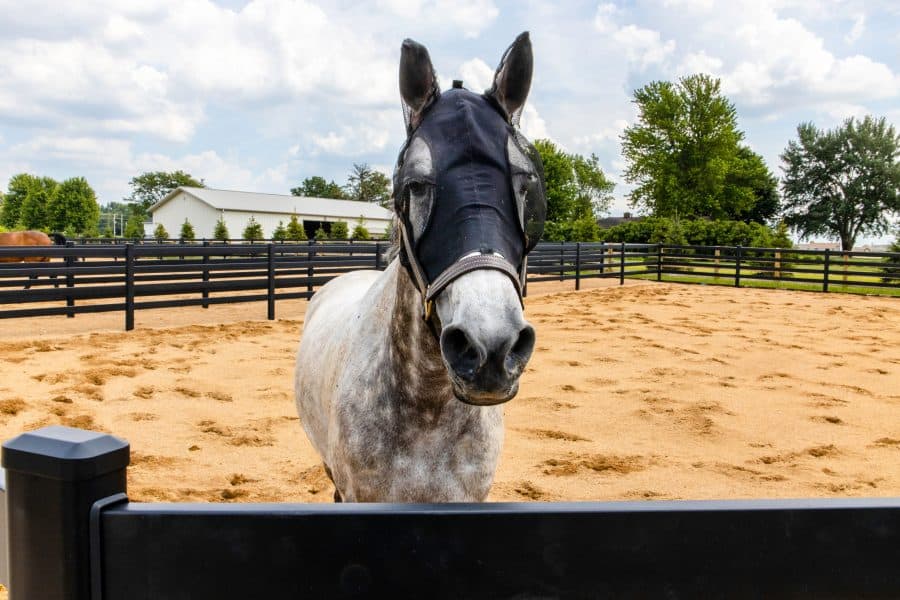THIS FENCE IS MADE
Color Options
Buckley Fence is offered in both texture black and gloss white. Choose texture black for understated elegance that blends in, or gloss white for a traditional look that stands out. Watch this video about choosing between black & white.

Rail Count Options
Choose our 4 rail for the most striking look to maximize beauty and strength; best for tight quarters and the toughest animals. Check out our gallery to view both our 3 and 4 rail.

Gate Options
Our gate lengths refer to the size of the gate openings. Gates can be used as singles or doubles, which allows for customization on your property. Comes in 3 or 4 rail in both our texture black or gloss white. Find all of our gate dimensions here & watch our gate installation video to learn more.

Planning Your Fence
How to Measure Your Property
1. Manually Measure
- Use a measuring tape, a long measuring wheel, or a laser distance measurer.
- Steps:
- Start at one corner of your property.
- Measure the distance along one side until you reach the next corner.
- Record each measurement.
- Continue measuring each side until you’ve covered the entire perimeter.
2. Use an Online Mapping Tool
- Our Buckley Draw Tool or online measuring tools like Google Earth give you a quick estimate of the perimeter.
- Open GeoDraw, Google Earth, or another map tool.
- Mark the corners of your yard by using the “distance measuring” feature to trace the outline of your yard.
- The tool will give you a fairly accurate perimeter measurement to help you estimate linear footage.
3. Professional Survey
- If you want high accuracy, hire a land surveyor. A surveyor can provide exact measurements and identify property boundaries.
4. Using GPS Tools
- Some GPS apps or devices (e.g., on smartphones or specialized GPS measuring devices) allow you to walk the perimeter while recording the distance. It’s less accurate than surveying but can give a reasonable estimate.
What Considerations Do I Need to Make if I Have Horses?
1. Plan for Pasture Rotation
- Multiple Pastures
- If you have the space, consider dividing your property into multiple fenced areas to rotate pastures. This allows one area to recover and grow while the horses graze in another.
- Cross Fencing
- Use cross fencing to section off parts of the property. This helps with pasture management, ensuring that no area gets overgrazed and horses have access to fresh grass. Our corner, tee, and 4-way posts are ideal for creating custom layouts. Learn about our fence installation in our written Fence Installation Instructions and Fence Installation Video.
Considering Gate Placement & Use
Deciding where to place gates on your fencing project requires consideration of several practical and aesthetic factors. Here’s a guide to help you make the best decision:
1. Identify Access Points
- Main Entry: The gate should provide easy access to your house, driveway, or any primary entrance areas. Consider where you enter and exit the property most frequently.
- Driveway Gate: If you’re installing a fence along your driveway, ensure the gate is wide enough for vehicles to pass through comfortably. Buckley Fence gates are offered in 4 ft, 8.5 ft, and 12 ft length openings that can be used as singles or doubles. Please reference our Gate Dimensions, written Gate Installation Instructions, and Gate Installation Video for a full breakdown of gate specifications.
- Secondary Gates: If you have a large property, multiple gates can provide convenience. You may want a smaller pedestrian gate for foot traffic or access to certain parts of your yard, like gardens or barns. Our 4 ft gates are ideal for situations like this.
2. Consider Functional Use
- Gardening Access: If you have a garden, place a gate near this area for easy access to gardening tools or maintenance equipment.
- Animal or Livestock: If you own animals like horses, consider where they move within the property and place gates accordingly. Ensure the gates are wide enough for equipment like tractors or horse trailers, if applicable. Many of our customers use a 4 ft and 12 ft gate in these situations since they allow for both pedestrian and equipment use simultaneously. Use our innovative Swinging Gate Latch system for dual gate set-up.
- Recreation Areas: If you have a patio, pool, or outdoor living space, ensure easy access from both inside and outside the fenced area. Our EZ Latch allows for opening in both directions.
3. Gate Size and Type
- Pedestrian vs. Vehicle Gates: Decide whether the gate is for foot traffic or vehicles. Our 4 ft gates are ideal for pedestrian purposes, while our 12 ft gates are ideal for vehicle passage.
- Wide Gates: If you have horses, make sure they’re wide enough for them to pass through comfortably. Our 12 ft gates are ideal for equipment access (tractors, trailers) and our smaller, 4 ft gates for pedestrian use can be helpful.
- Strategic Placement: Place gates in areas that allow easy access to different paddocks, shelters, or feeding areas. Gates should also be wide enough for horse handling and movement. Choose our 8.5 ft and 12 ft gates for these types of situations.
Safe Latching Mechanism: Our EZ Latch allows gates to open both directions in any situation. They’re easy to operate, horse-proof, and durable for decades. Check out our written EZ Latch Installation Instructions and EZ Latch Installation Video for more details.
Gate Placement in Dry Lots, Turnouts, and Paddocks
When planning fencing for dry lots, turnouts, and paddocks, here are key considerations to ensure durability, functionality, and animal safety:
1. Gate Placement in Each Area
-
- Dry Lots:
- Centralized placement: Position gates near where animals will be brought in or out, typically closest to the barn, stable, or feeding area.
- Animal control: Place gates in a corner if possible, as animals are more likely to gather there, making it easier to manage their movement.
- Convenience for Clean-Up: Make sure gates allow access for equipment needed for cleaning and maintenance, such as skid steers or manure spreaders.
- Dry Lots:
-
- Turnouts:
- Frequent Use: Since turnouts are used for short-term access, place gates where you’ll enter and exit often, typically near pathways or lanes leading to other areas like paddocks or barns.
- Animal Flow: Position the gate in a way that guides animals toward the turnout without causing congestion or requiring sharp turns.
- Visibility: Make sure gates are easy to see and locate for both animals and handlers, particularly if using multiple turnouts or rotating usage.
- Slope and Runoff: Ensure gate areas have proper drainage, as frequent traffic in turnouts can lead to muddy, slippery ground.
- Turnouts:
-
- Paddocks
- Location: Place gates in corners or along a central line, ideally toward the area where you enter or exit the paddock. This minimizes walking distance for handlers and animals.
- Accessibility: Position gates where vehicles or equipment like feed trucks or tractors can easily access the paddock for maintenance or feeding.
- Drainage: Avoid low spots or areas prone to water accumulation, as muddy gates make entry difficult and can wear down the ground around the gate.
- Multiple Access Points: For larger paddocks, consider installing multiple gates to allow easy access to different areas and improve traffic flow.
- Paddocks
2. Spacing and Visibility
- Fencing for paddocks should allow animals to see each other or other paddocks to reduce stress.
- Plan for adequate spacing between fencing and gates to prevent crowding and ensure efficient movement.
Considering these aspects in your fencing project can ensure that each area meets the needs of your animals while keeping maintenance manageable and the environment safe.
What if My Animals Are Rambunctious?
1. Rail Reinforcement
-
- If your horses are prone to leaning on or pushing the fence, you might want to add rail reinforcement (with our Z-Bars) which are easily inserted into the rail, twisted slightly at about 12 degrees. The Z Bar uses itself as a natural spring to create friction. Without the reinforcement our rails give us a rail strength of 1200 lbs vertically and 400 lbs horizontally, with 4″ of flex for safety. Reinforced rails withstand 75% more horizontal force to the point of bending. Learn more about our Z-bars in our Rail Reinforcement Video.
2. Hot Wire Addition
-
-
- Some customers find adding a strand or two of hot wire discourages horses from leaning against the side of the fence. These are often installed in tight quarters and with rambunctious horses. Our Hot Wire Insulators are used to attach hot wire to our fencing. These are often installed in tight quarters and with rambunctious horses. Please reference our Hot Wire Insulator Installation Instructions or Hot Wire Installation Video for more details.
-
What if I Have Small Animals?
- Adding Wire Mesh
-
- Many of our customers with smaller animals utilize our Wire Mesh Clips which allows you to add wire mesh to your fence. This is an easy addition to your fence to keep smaller animals safely inside your enclosure. Please check out our Video on Wire Mesh Clips, our Wire Mesh Clip Installation Instructions, and our Wire Mesh Placement Diagrams for more details.
Installation Considerations
1. DIY vs. Professional Installation
-
- Installing the fence yourself can save on labor costs but may require special tools, equipment rentals, and time. Professional installation varies in price per foot depending on the complexity of the project, terrain, and travel considerations for the installer.
2. Finding an Installer
-
- Buckley Fence sales reps can connect you with an installer in your area throughout the sales process. Most installers who are comfortable installing wood & vinyl, are able to install Buckley Fence (as long as they have access to the required equipment). Find all of our installation details, required pieces or equipment, and unique aspects of Buckley Fence on our Installation Page.
Doesn’t the Fence Get Hot in the Summer?
- Our texture black will heat to about 15 or 20° above ambient depending on wind speed. Our texture black will heat to 115-120°F and our gloss white to around 100°F on a 100°F day. Rule of thumb: the black fence will not get hotter than a black car.
Buckley Fence Dimensions


- 2, 3, and 4 rail are 57″ from ground to top post.
- Each section is 9.65′, longer and stronger than wood or vinyl.
- Post center to post center is 115 3/4″.
- Ground to bottom rail is 12″.


Buckley Fence FAQ
How Long is Your Warranty?
- We guarantee that the fence will be free from defects in material and workmanship and that the electro-statically applied paint
finish will not crack, chip, or peel for as long as the original purchaser owns the fence or 15 years, whichever comes first.
What Type of Steel is the Fence Made Of?
- Our steel board posts & gates are made with a low carbon steel, equivalent to ASTM 1020 Steel. Low carbon steel lacks alloys
and heat treatment, making it ductile and easily bendable. Higher strength steel is more brittle, so for this product, low carbon
steel is ideal.
Won’t the Fence Rust?
- Our fence has a four-layer coating that protects it against rust. Our base steel is coated with a zinc layer, a conversion coating,
an epoxy primer, and then a polyester-based powder coating which will not chip, peel, or crack and has superior long-term
resistance to rusting, fading, or chalking. - Learn more about our world-class, four-layer coating here.
What Gauge is the Steel?
- The steel is 18 gauge on rails, 16 gauge on posts. The shape gives us a rail strength of 1200 lbs vertically and 400 lbs horizontal-
ly, with 4″ of flex for safety.
How Strong is the Fence?
- Post strength withstands 1,200 lbs of force horizontally. Rail strength withstands 1,200 lbs vertically and 400 lbs horizontally.
When a rail is reinforced with our Z-bar, the horizontal strength increases to 700 lbs.
What Gates Do You Offer?
- Our gates come in three different sizes: 4 ft, 8 ft 4 5⁄8 in, and 12 ft. Gate lengths refer to size of the gate openings. The gates can be installed as singles or doubles and are sold separately. They can be installed with Buckley Fence, or almost any other fence. Available in texture black and gloss white, and 3-rail and 4-rail.
- Find all of our gate dimensions here.
Is the Fence Eco-Friendly?
- Our architectural-grade powder-coat is applied with no emissions, unlike with wet paint used on wood or chemicals used in treated wood or PVC. This product is fully recyclable and is produced with the world’s most recycled material–steel.
- Learn more about how eco-friendly Buckley Fence is here.
What Rail Counts Are Available?
- We offer 3 and 4 rail fences, both of which are 54″ from ground to top of top rail. Our fence is used for equestrian, ranch, and
residential purposes. We do not have privacy fences. - Find all of our fence dimensions here.
Are the Grommets Just as Durable as the Fence?
- Our grommets are durable and will last decades, like the rest of the fence. Our grommets are constructed with EPDM rubber, a
resilient material commonly employed in industrial roofing applications, which boasts a remarkable 50-year warranty. - Learn more about our grommets here.
What’s Involved in the Installation Process?
- We designed the fence with easy assembly and installation in mind. Our posts are set further apart than other fences, but set
deeper in the ground with wet concrete. Once posts are set, the rest is easy–insert grommets, slide in rails, drop in lock
spacers, and put on post caps. There are no nails, screws, or fasteners.
What if I Have Uneven Terrain I Want to Install on?
- The posts and rails were designed so that the fence can easily be installed at steep angles. The rails can be angled up or
down, left or right by 22.5 degrees where they insert into the post.
How Do I Keep Smaller Animals (Like Dogs) Inside the Fence?
- We designed Wire Mesh Clips that allow you to install any wire mesh to our fence without compromising the integrity of the
Buckley Fence powder-coated finish. We recommend black vinyl-dipped wire mesh for an elegant look. - Learn more about our Wire Mesh Clips here.
What if I Need to Install Hot Wire?
- Our Hot Wire Insulators can be used so you can easily install any hot wire or tape without damaging the Buckley Fence
powder-coated finish. This is especially recommended when containing livestock. - Learn more about our Hot Wire Insulators here.
How Safe is the Fence for Horses?
- Our fence has proven time and time again to be the safest option for horses, especially due to our bend, buckle, and release
technology. Each board will bow at 400 pounds of pressure and then spring back into perfect true form under that amount of
pressure. At a full on stampede run, if a horse hits the board, it will bow and then break out and away from the horse. Given the
height and surface area of the board, the animal will not even be bruised. The fence is also highly visible to horses with
smooth, rounded edges. No shards, barbs, splinters, nails, or screws to cause injuries. - Learn more about how horse safe Buckley Fence is here & why UGA College of Veterinary Medicine chose Buckley for their fencing.
What About Cribbing?
- It is possible for cribbing to cut through even well-adhered paint, which is not covered under warranty. If the paint is flaking,
Buckley Fence is responsible and would instruct the customer to touch up the affected area with the paint, provided by us.
How Does the Fence Hold up to Extreme Weather? (i.e. Hurricanes or Tornadoes)
- Our fence withstands winds well over 100 mph. We’ve never had a wind issue with hurricanes and nearby tornados (across the
road), including one customer whose fence was completely submerged after a hurricane, with no damage after the storm.
What About Hail?
- Our fence is extremely hail resistant. A testimonial from one customer in Longmont, CO tells us that their cars were totaled and roof shingles were destroyed, but they couldn’t see a single dent in the fence.
How About Lightning?
- Since each section of our fence is isolated by rubber grommets, a strike does not travel the fence line like in a welded pipe
fence. Instead, it travels to the ground at the nearest post without jumping to the next rail set. - Learn more about our grommets here.
What About Mold Growth?
- This metal product is not conducive to mold or mildew growth, unlike plastic and wood products. In highly damp environments
with zero sun exposure, mold growth is technically possible, but would not damage the fence, and would simply need to be
cleaned.
Doesn’t the Fence Get Hot in the Summer?
- Our texture black will heat to about 15 or 20° above ambient depending on wind speed. Our texture black will heat to 115-120°F and our gloss white to around 100°F on a 100°F day. Rule of thumb: the black fence will not get hotter than a black car.
Have More Questions?
Shipping FAQ
Do You Sell Buckley in My Area?
- We manufacture and ship the product anywhere and everywhere and can then connect you with an installer in your area. Depending on volume, your shipment will either come from our warehouse or direct from the manufacturer.
Do you install the fence as well, or is the price just for the fence?
- Buckley Fence does not do installation. Our prices are for materials, shipping, and taxes only.
How to find an installer
- We have a large network of installers throughout the country that we work with to accomplish the installation process for customers. Buckley Fence acts as a resource for installers throughout the process and can help troubleshoot any install questions. Please review our How-To videos and install documents prior to starting your fence project.
Free Quote
To get a free quote, you will need…
Our sales team will then reach out to you in 2-3 business days to discuss your project!
Installation Overview
Buckley Fence does not do installation. We have a large network of installers throughout the country that we work with to accomplish the installation process for customers. Buckley Fence acts as resource for installers throughout the process and can help troubleshoot any install questions. Please review our How-To videos and install documents prior to starting your fence project. Please contact Buckley Fence for any additional installation instructions: Call 720-644-6884 or email sales@buckleyfence.com.
Installer Need to Knows
- Required Equipment
- Skid steer with capacity to lift 3500 lbs or more.
- Auger with extension to at least 43″ for fence post holes.
- Auger + hand digging to 54″ for gate post holes.
- Mud hog recommended for larger jobs – pays for itself in the first 5,000 ft.
- Setting the posts
- All posts are installed with mixed, wet concrete for longevity.
- Pea gravel works well as a substitute for semi-permanent installations.
- Unique Dimensions
- Post center to post center is 9.65′ – longer, stronger, and more striking than wood or vinyl.
- Gate lengths refer to the length of the gate opening, not gate length. Please reference our Gate Dimensions sheet for specifics.
- No nails, screws, or fasteners
- Rails are easily installed using our ingenious lock spacer system.
How Does Buckley Compare to the Competition?
Outperforms other fencing in safety, durability, ecological impact and beauty.
| Wood Board | Plastic (Vinyl & PVC) | Polymer Coated Wire Flex | Welded Steel Pipe | Buckley Steel Board Fence | |
|---|---|---|---|---|---|
| Appearance | |||||
| Maintenance | |||||
| Safety | |||||
| Life Span | |||||
| Strength | |||||
| Lifetime Value | |||||
| Eco Friendly |

